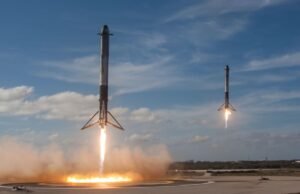Arctic Circle
The Arctic Circle is an imaginary boundary that encircles the northernmost part of the Earth. It is located at approximately 66.5 degrees latitude, encompassing parts of several countries including Norway, Sweden, Finland, Russia, Canada, Greenland (Denmark), and the United States (Alaska). The region within the Arctic Circle is known for its unique climate, wildlife, and indigenous cultures.
Key Takeaways:
- The Arctic Circle marks the northernmost boundary of the Earth.
- It spans multiple countries including Norway, Sweden, Finland, Russia, Canada, Greenland, and the United States (Alaska).
- The region within the Arctic Circle is known for its unique climate, wildlife, and indigenous cultures.
Climate and Geography
The Arctic Circle experiences extremely cold temperatures throughout the year, with long, harsh winters and relatively short summers. The average temperatures can drop below -30°C (-22°F) in winter, while in summer they can reach up to 10°C (50°F). The region is characterized by frozen ocean (sea ice) and vast expanses of tundra, which is a treeless landscape with low-growing vegetation.
The Arctic Circle is a land of extreme temperatures and its landscape is dominated by frozen ocean and tundra.
Wildlife
The Arctic Circle is home to a diverse range of wildlife, adapted to the harsh conditions of the region. Some iconic species include the polar bear, Arctic fox, reindeer, walrus, and several species of seals and whales. Many of these animals have unique adaptations such as thick fur, layers of fat for insulation, and specialized hunting techniques for survival in the cold environment.
The wildlife in the Arctic Circle has fascinating adaptations that help them survive in the extreme Arctic conditions.
Indigenous Cultures
The Arctic Circle is inhabited by several indigenous cultures that have lived in the region for thousands of years. These include the Inuit people in Canada and Greenland, Sami people in Scandinavia, and various indigenous groups in Russia and Alaska. These communities have rich cultural traditions, often centered around hunting, fishing, and reindeer herding. They have a deep connection with the land and rely on its resources for their livelihood.
The indigenous cultures in the Arctic Circle have a long history and a strong connection with the land and its resources.
Interesting Arctic Circle Facts
- The Arctic Circle experiences a phenomenon called the Midnight Sun, where the sun remains visible for 24 hours during the summer solstice.
- The region is home to the world’s northernmost settlements, some of which are inhabited year-round.
Data and Statistics
| Country | Arctic Circle Land Area (sq km) | Percentage of Country’s Land Area |
|---|---|---|
| Norway | 146,733 | 13.7% |
| Sweden | 67,861 | 2.7% |
| Finland | 36,375 | 13.1% |
| Russia | 5,500,000 | 6.8% |
| Canada | 1,424,500 | 10.3% |
| Greenland (Denmark) | 1,710,000 | 100% |
| United States (Alaska) | 1,723,337 | 20.3% |
Threats and Conservation
The Arctic Circle is facing numerous challenges due to climate change and human activities. The rapidly melting sea ice is endangering species such as the polar bear and walrus, while the thawing permafrost is impacting infrastructure and ecosystems. Oil and gas exploration, shipping, and industrial fishing also pose risks to the delicate Arctic environment.
- Climate change and melting sea ice are major threats to the Arctic Circle’s ecosystem.
- Human activities like oil and gas exploration and industrial fishing pose additional risks.
Arctic Council
The Arctic Council is the leading intergovernmental forum for promoting cooperation and coordination among Arctic states and indigenous communities. It addresses common issues related to sustainable development and environmental conservation in the Arctic region. The council consists of eight member countries, including Canada, Denmark, Finland, Iceland, Norway, Russia, Sweden, and the United States.
The Arctic Council plays a crucial role in addressing Arctic-specific challenges and promoting sustainable development in the region.
Data and Statistics
| Indicator | Value |
|---|---|
| Number of Inuit People in Canada and Greenland | Approximately 160,000 |
| Number of Sami People in Scandinavia | Approximately 100,000 |
| Number of Indigenous Groups in Russia | Over 40 |
| Number of Indigenous groups in Alaska | Over 20 |
Conclusion
The Arctic Circle is a region of immense natural beauty and cultural significance. It is a fragile ecosystem facing numerous challenges, but also a place of rich biodiversity and indigenous heritage. Preserving the Arctic’s unique characteristics and addressing the impacts of climate change and human activities is crucial for the well-being of both the region and the entire planet.
Common Misconceptions
Climate and Weather
- The Arctic Circle is always extremely cold and covered in snow.
- The Arctic Circle does not experience any season other than winter.
- Polar bears roam freely all over the Arctic Circle.
Contrary to popular belief, the Arctic Circle is not always extremely cold and covered in snow. While it is true that temperatures can be frigid, especially during the winter months, the Arctic Circle does experience a summer season with milder temperatures. Additionally, it is a common misconception that the Arctic Circle only has one season, which is winter. In reality, the Arctic has distinct seasons, including summer, autumn, and spring.
Landscape and Features
- The Arctic Circle is an entirely barren and desolate landmass.
- There are no plants or vegetation in the Arctic Circle.
- The Arctic Circle is just a vast expanse of ice and nothing more.
The belief that the Arctic Circle is an entirely barren and desolate landmass is not accurate. While some areas may appear barren due to the harsh conditions, the Arctic Circle is home to a variety of plant and animal life. It is also a common misconception that there is no vegetation in the Arctic Circle. In reality, the region is home to a range of plant species, including mosses, lichens, and shrubs. Additionally, the Arctic Circle is not just a vast expanse of ice; it also includes mountains, fjords, and other geological features.
Inhabited by Humans
- No one lives in the Arctic Circle.
- The Arctic Circle is a completely uninhabitable region.
- There are no communities or civilizations in the Arctic Circle.
Contrary to popular belief, the Arctic Circle is not devoid of human presence. While it is true that the region is sparsely populated compared to other areas of the world, there are communities and civilizations that call the Arctic Circle home. Indigenous peoples such as the Inuit have lived in the Arctic Circle for thousands of years and have adapted to the harsh conditions. Furthermore, there are also research stations, military outposts, and other human settlements in the region.
Effects of Climate Change
- Climate change does not impact the Arctic Circle.
- The melting of Arctic ice does not affect global sea levels.
- Arctic wildlife is not threatened by climate change.
A common misconception is that climate change does not significantly impact the Arctic Circle. However, the region is one of the areas most affected by global warming. The melting of Arctic ice not only contributes to rising sea levels but also disrupts the ecosystems and threatens the survival of Arctic wildlife. The loss of sea ice has repercussions for species like polar bears, seals, and walruses that depend on it for hunting and breeding. Additionally, climate change affects the delicate balance of the region’s biodiversity, from algae and plankton to larger marine mammals and birds.
The Arctic Circle and Its Ecological Importance
The Arctic Circle, located at approximately 66.5 degrees north latitude, encompasses the northernmost region of the Earth. This vast area is renowned for its unique and fragile ecosystem, which plays a vital role in global climate regulation. The following tables shed light on fascinating aspects of the Arctic Circle and its ecological significance:
The Five Arctic Coastal Countries
The Arctic Circle is home to five coastal countries, each with its own distinct characteristics and responsibilities for the region. The table below provides an overview of these nations:
| Country | Area (sq. km) | Population (2019) | Main Language |
|—————–|—————|——————:|———————|
| Canada | 9,984,670 | 37,067,011 | English, French |
| Denmark (Greenland) | 2,166,086 | 56,672 | Greenlandic |
| Norway | 385,207 | 5,421,747 | Norwegian |
| Russia |17,098,242 | 144,526,636 | Russian |
| United States (Alaska) | 1,717,856 | 731,545 | English |
Arctic Circle Wildlife
The Arctic Circle is teeming with diverse and resilient wildlife, uniquely adapted to the extreme environmental conditions. The table illustrates some of these incredible species:
| Species | Lifespan | Habitat | Conservation Status |
|——————–|————-:|———————–|———————–|
| Polar Bear | 25-30 years | Sea ice and tundra | Vulnerable |
| Arctic Fox | 3-6 years | Tundra and coastal | Least Concern |
| Beluga Whale | 50-60 years | Arctic waters | Near Threatened |
| Arctic Hare | 1-5 years | Tundra and mountains | Least Concern |
| Walrus | 20-30 years | Sea ice and coasts | Vulnerable |
Arctic Circle Indigenous Peoples
The Arctic Circle is home to a rich tapestry of diverse indigenous communities, each contributing unique cultural heritage. The table below highlights some of these remarkable groups:
| Indigenous Group | Location | Main Language | Population Estimate (2019) |
|————————-|———————–|———————–|—————————-|
| Inuit | Canada, Greenland | Inuit languages | 160,000 |
| Sami (Lapland) | Norway, Sweden, Finland | Sami languages | 65,000 |
| Nenets | Russia | Nenets language | 44,640 |
| Aleut | Alaska, Russia | Aleut language | 1,738 |
| Evenk | Russia, China | Evenki language | 36,369 |
Threats to Arctic Biodiversity
The Arctic Circle faces multiple threats that endanger its delicate biodiversity. The table presents some of the major challenges the region encounters:
| Threat | Description |
|————————————|——————————————————————————————————|
| Melting Sea Ice | Shrinking ice cover disrupts habitat for polar bears, seals, and walruses. |
| Ocean Acidification | Increased carbon dioxide absorption leads to acidification, impacting marine organisms’ survival. |
| Overfishing | Unsustainable fishing practices deplete fish stocks, disrupting the food chain. |
| Pollution | Pollutants from shipping, oil drilling, and industrial activities harm Arctic species and ecosystems. |
| Habitat Fragmentation | Human activities fragment habitats, limiting animal movements and migration patterns. |
Arctic Circle Climate Change
The Arctic Circle experiences the brunt of climate change, impacting its intricate ecosystem. The table highlights some key climate change indicators:
| Indicator | Change Over the Last Decade | Implications |
|————————————|———————————————————–|———————————————————————————————–|
| Average Arctic Temperature | Increased by 2.3°C (4.1°F) | Accelerates ice melt, alters species distribution patterns, and disrupts ecological balance. |
| Sea Ice Extent | Reduced by approximately 13% | Endangers polar bears, narwhals, and other ice-dependent species. |
| Glacial Mass Loss | 70-120 Gt per year (200 billion to 400 billion tons) | Contributes to rising sea levels and impacts freshwater availability for Arctic communities. |
| Permafrost Thawing | Thawing 0.5 cm (0.2 inches) deeper annually | Releases greenhouse gases, exacerbating global warming and triggering feedback loops. |
| Ocean Acidification | pH decreased by 0.02 (acidification) | Deteriorates the health and survival of marine organisms, especially those with shells. |
Renewable Energy in the Arctic
The shift toward renewable energy sources plays a crucial role in sustainable development in the Arctic Circle. The following table presents the renewable energy capacity of various Arctic countries:
| Country | Renewable Energy Capacity (MW) | Main Sources |
|—————–|——————————-:|————————————-|
| Canada | 28,652 | Hydropower, Wind, Biomass |
| Denmark (Greenland) | 562 | Hydropower |
| Norway | 14,886 | Hydropower, Wind, Biomass |
| Russia | 10,743 | Hydropower, Wind, Solar, Biomass |
| United States (Alaska) | 3,663 | Hydropower, Wind, Biomass, Solar |
Sustainable Tourism in the Arctic
With the Arctic’s allure attracting more tourists than ever, sustainable tourism practices are imperative to preserve this delicate environment. The following table showcases the visitor numbers in popular Arctic destinations:
| Destination | Visitors (2019) | Main Attraction |
|——————-|——————:|—————————————-|
| Svalbard (Norway) | 140,873 | Wildlife, Glaciers |
| Greenland | 115,650 | Ice Fjords, Northern Lights |
| Alaska (USA) | 2,262,048 | National Parks, Scenic Landscapes |
| Lapland (Finland) | 1,387,839 | Northern Lights, Santa Claus Village |
| Baffin Island (Canada) | 19,574 | Inuit Culture, Arctic Wildlife |
The Significance of Arctic Circle Research
Research conducted in the Arctic Circle is vital to deepening our understanding of climate change and its impacts. The table below demonstrates some contributions resulting from scientific studies in this region:
| Area of Research | Contribution |
|————————————-|——————————————————————————————————|
| Climate Models & Predictions | Informs global climate models and projections, aiding policymakers in developing mitigation strategies.|
| Arctic Food Web Dynamics | Illuminates the intricate relationships within the Arctic food chain, guiding conservation efforts. |
| Glacial & Permafrost Studies | Provides insight into past climate change, permafrost melting rates, and future sea level rise. |
| Endangered Species Monitoring | Monitors population trends and helps implement effective measures for the conservation of species. |
| Indigenous Traditional Knowledge | Integrates indigenous knowledge systems with scientific research, leading to holistic approaches. |
Conclusion
The Arctic Circle’s ecological importance cannot be overstated. Its diverse wildlife, indigenous communities, and unique ecosystems are under significant threat due to climate change, pollution, and other human-induced activities. Protecting and conserving this remarkable region entails global cooperation and sustainable practices. By recognizing the significance of the Arctic Circle, we can foster a greater sense of responsibility toward this fragile ecosystem, ensuring its survival for future generations.
Frequently Asked Questions
What is the Arctic Circle?
The Arctic Circle is an imaginary line located at approximately 66.5 degrees north of the equator. It marks the southernmost point where the sun can stay continuously above or below the horizon for 24 hours during the summer and winter solstices respectively.
Where is the Arctic Circle located?
The Arctic Circle passes through several countries and bodies of water, including Norway, Sweden, Finland, Russia, the United States (Alaska), Canada, Greenland, and the Arctic Ocean.
What is the climate like in the Arctic Circle?
The climate in the Arctic Circle is characterized by long, cold winters and short, cool summers. Temperatures often drop below freezing and the region is covered in snow and ice for most of the year.
What wildlife can be found in the Arctic Circle?
The Arctic Circle is home to a diverse range of wildlife including polar bears, reindeer, walrus, Arctic foxes, seals, whales, and a variety of bird species. These animals have adapted to the harsh Arctic conditions to survive.
Are there any indigenous communities in the Arctic Circle?
Yes, there are several indigenous communities that have lived in the Arctic Circle for thousands of years. These include the Inuit, Yupik, Saami, Nenets, and many others. They have unique cultures and rely on hunting, fishing, and herding for their livelihoods.
Can you see the Northern Lights in the Arctic Circle?
Yes, the Arctic Circle is one of the best places in the world to see the Northern Lights, also known as Aurora Borealis. The natural phenomenon occurs when charged particles from the sun collide with atoms in the Earth’s atmosphere, creating colorful light displays in the night sky.
Is it possible to visit the Arctic Circle?
Yes, it is possible to visit the Arctic Circle. There are several tour operators and cruise companies that offer trips to Arctic destinations, allowing visitors to experience the unique scenery and wildlife of the region. However, it is important to be well-prepared and make necessary arrangements before visiting due to its remote and challenging environment.
What are some threats facing the Arctic Circle?
The Arctic Circle is facing several threats due to climate change. The melting of polar ice caps, rising sea levels, loss of habitat for wildlife, and changes in the delicate Arctic ecosystem are some of the major concerns. Additionally, increased human activities such as oil and gas exploration pose risks to the fragile environment.
What are the economic activities in the Arctic Circle?
The economic activities in the Arctic Circle include fishing, hunting, tourism, mining, oil and gas exploration, and shipping. However, these activities must be carefully managed to minimize their impact on the environment and ensure the sustainable development of the region.
Are there any international agreements for the protection of the Arctic Circle?
Yes, there are several international agreements and organizations focused on the protection and conservation of the Arctic Circle. One notable agreement is the Arctic Council, which includes eight Arctic states and representatives from indigenous communities. The council aims to promote cooperation and sustainable development in the region.



